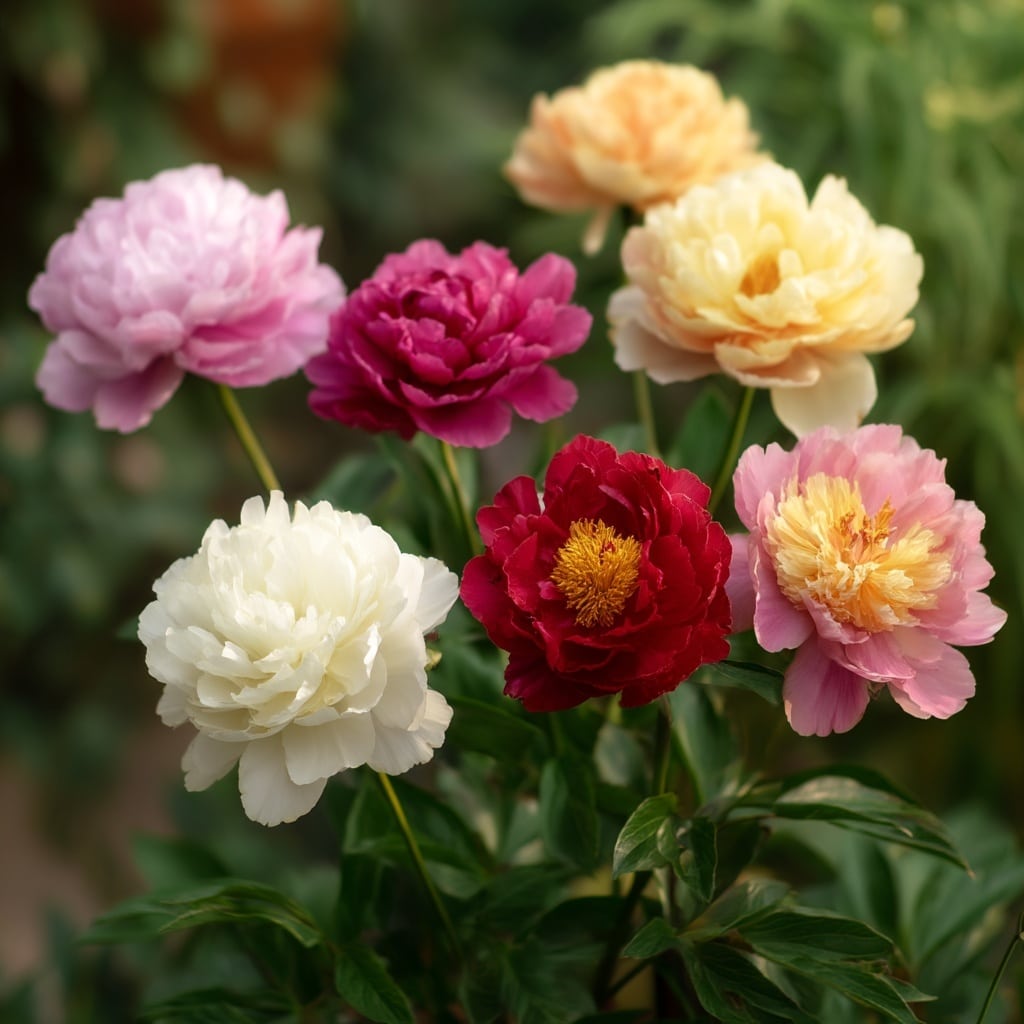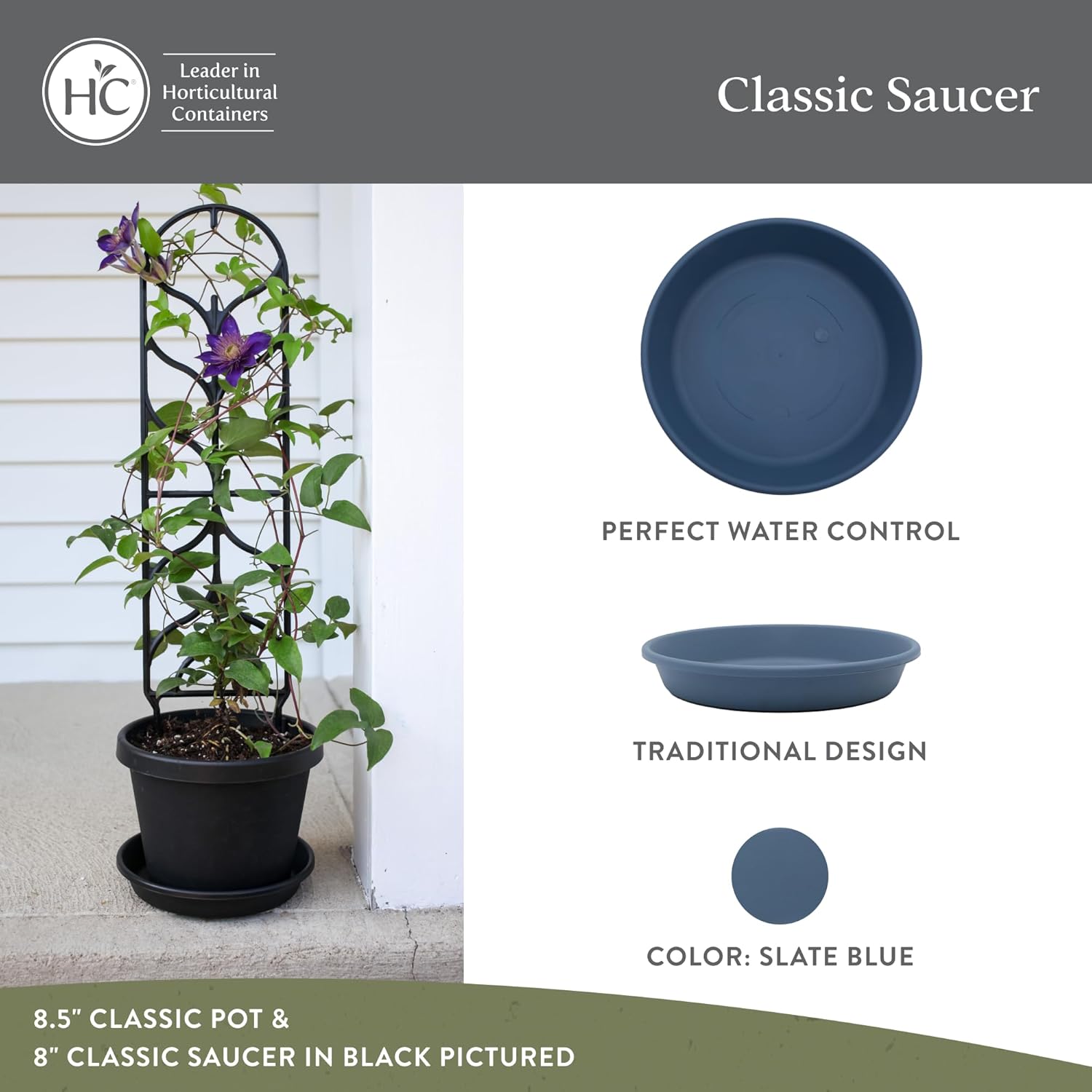Peonies are among the most cherished perennial flowers in home gardens, known for their lush blooms, fragrant scent, and remarkable longevity. Once established, these plants can thrive for decades—some even lasting over 100 years—with little more than sunlight and well-prepared soil. Their large, layered flowers bloom in late spring or early summer, turning heads with every breeze. Whether you’re new to gardening or a seasoned grower, peonies offer both beauty and resilience, making them a perfect addition to any flower bed, border, or bouquet. In this guide, you’ll learn exactly how to plant and grow peonies for years of spectacular blooms.
Table of Contents
Where to Plant Peonies
Choosing the right location is essential when growing peonies, as these long-lived perennials don’t appreciate being moved once settled. Pick a spot where they can remain undisturbed for many years. The ideal site receives 6 to 8 hours of full sun each day. While peonies can tolerate partial shade, too little sunlight will reduce bloom quality and quantity.
Look for a location with well-draining, fertile soil rich in organic matter. If your soil is heavy or clay-based, improve it with compost or aged manure before planting. Avoid planting too close to large trees or shrubs, which may compete for nutrients, water, and sunlight.
Since peonies have large, showy flowers that can become top-heavy, a sheltered area protected from strong winds will help prevent stem breakage. If wind exposure is unavoidable, plan to provide support like peony rings or stakes as they grow.
When to Plant Peonies
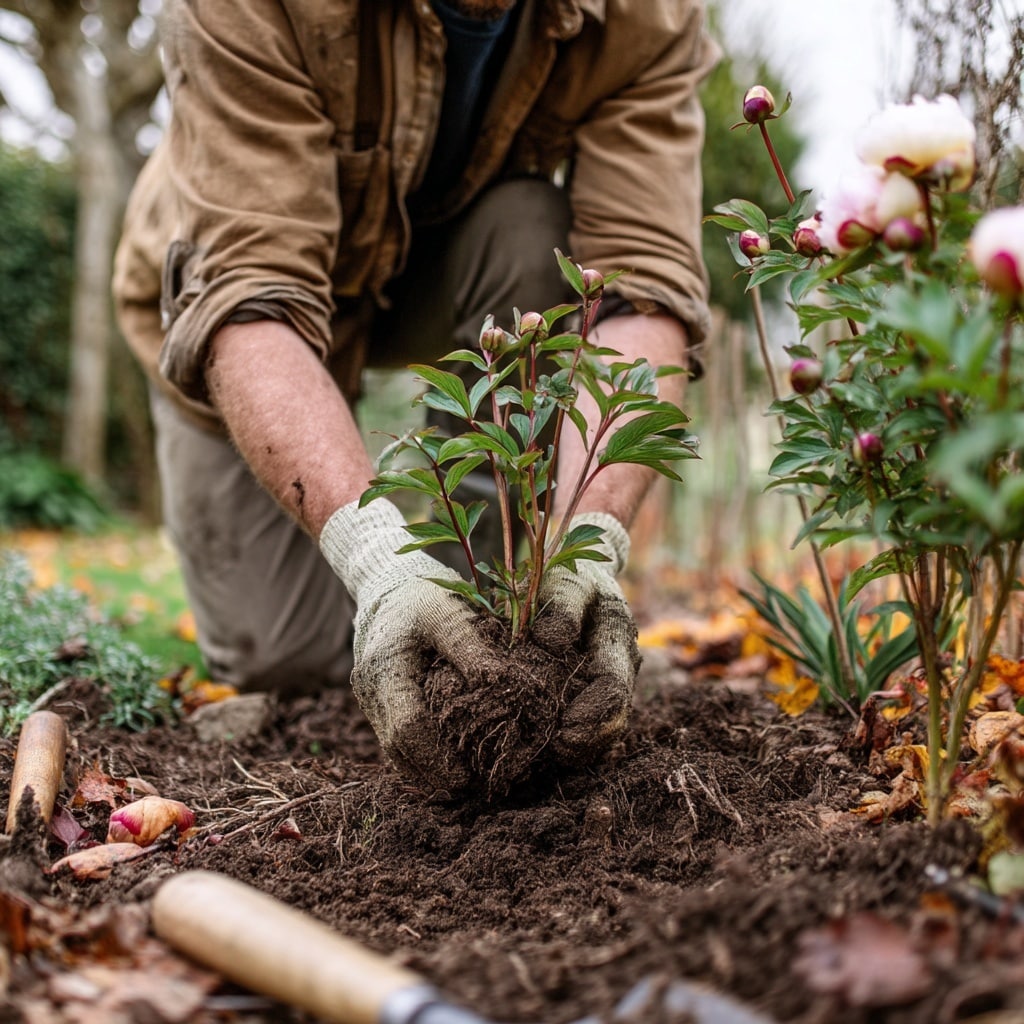
The best time to plant peonies is in the fall, typically between late September and early November, depending on your region. Planting during this period allows the roots to establish before winter dormancy, setting the stage for strong growth and blooming in the spring.
If you live in Zones 7 or 8, you can plant a bit later in the fall, but always aim to get your peonies in the ground at least six weeks before the first hard frost. This timing gives the roots enough time to settle into their new environment.
While spring planting is possible, it’s not ideal. Peonies planted in spring tend to lag behind fall-planted ones, often taking longer to establish and bloom. If spring planting is your only option, expect a delay of at least a year in flowering performance.
Proper timing is key to long-term success with peonies—plan ahead for the best results.
How to Plant Peonies
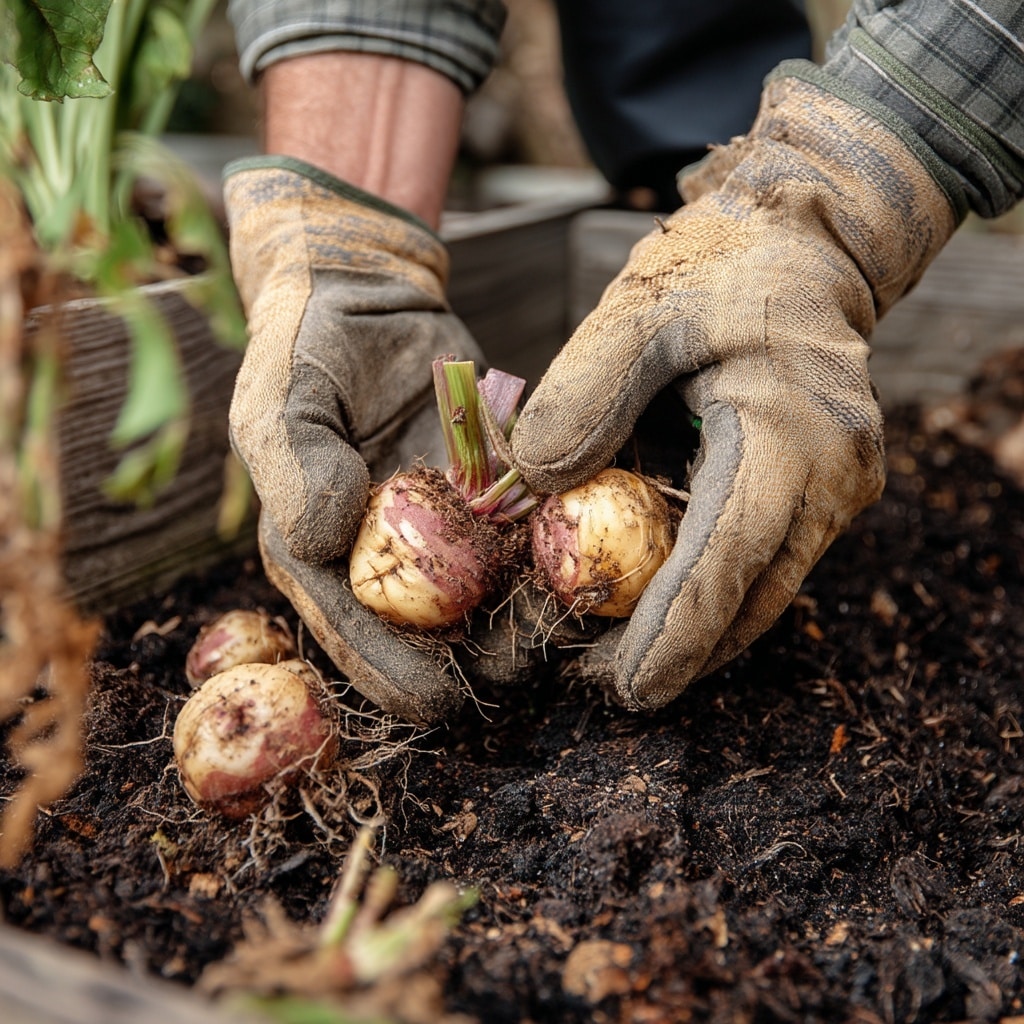
Planting peonies correctly from the start ensures healthy growth and consistent blooms for decades to come. These plants are usually sold as bare-root tubers with 3 to 5 “eyes” (small pink or white buds), and proper depth is crucial when placing them in the soil.
Steps for Planting Peonies:
- Spacing: Space plants 3 to 4 feet apart to allow for airflow and prevent fungal diseases.
- Digging the hole: Create a hole about 2 feet deep and wide. Mix compost or aged manure into the backfill soil to enrich it.
- Planting depth: Place the root so that the eyes face upward and sit no more than 2 inches below the soil surface. Planting too deep is a common cause of poor blooming.
- Backfilling: Gently refill the hole and tamp the soil lightly. Avoid compacting it too much.
- Watering: Water thoroughly after planting to settle the soil and remove any air pockets.
For warmer climates, choose early-blooming peonies, plant them slightly shallower (about 1 inch deep), and provide light afternoon shade to prevent heat stress.
When and How Peonies Bloom

Peonies are known for their stunning, oversized blooms that typically appear from late spring to early summer, depending on the variety and your climate. Some bloom as early as May, while others extend the season into June. To enjoy peonies for as long as possible, consider planting a mix of early-, mid-, and late-season varieties.
Once established, peonies bloom reliably year after year with little effort. However, new plants may take 2 to 3 years to produce full blooms. In their first year, you might see limited or no flowers as the roots focus on establishing strength underground.
Peonies thrive in cooler climates and actually benefit from cold winters, which help trigger bud formation. That’s why they’re well suited for USDA Zones 3 through 8.
With the right care and location, your peonies will reward you with lush, fragrant flowers that return stronger each season.
How to Care for Peonies

Once established, peonies are surprisingly low-maintenance and can thrive with very little attention. In fact, they often do best when left alone, making them ideal for gardeners who appreciate beauty without the fuss.
General Care Tips:
- Watering: Peonies prefer moist, well-draining soil. Water deeply during dry spells, especially in the first couple of years.
- Fertilizing: Avoid overfeeding. If the soil is healthy, an annual top-dressing of compost or a balanced fertilizer after blooming is usually sufficient. Don’t fertilize more than every few years.
- Staking: Some varieties produce heavy blooms that can cause stems to bend or break. Use peony rings or wire cages early in the season to provide support.
- Deadheading: Remove spent flowers by cutting the stem down to a strong leaf. This prevents energy from going into seed production and keeps the plant tidy.
With just a bit of care, your peonies will become stronger and more vibrant each year.
Fall and Winter Peony Care
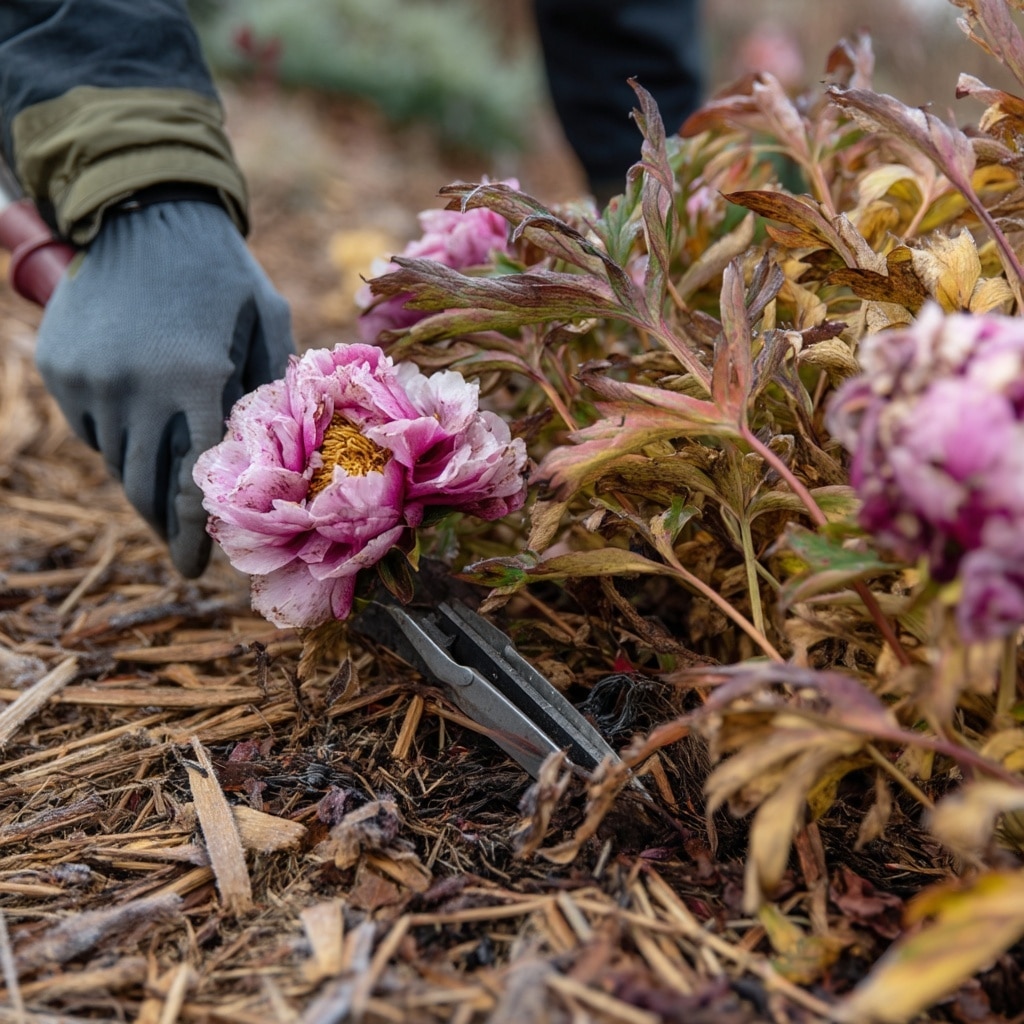
As the seasons shift, preparing your peonies for winter helps protect their roots and ensures a healthy return next spring. Fortunately, fall care is simple and doesn’t require much effort.
Fall Cleanup Tips:
- Cut back foliage after the first frost. Once the leaves turn brown, trim stems down to ground level to prevent overwintering pests or diseases.
- Do not mulch heavily. Peonies don’t like to be smothered. In colder climates, a light mulch of pine needles or shredded bark can help protect newly planted roots—just be sure to remove it in early spring.
- Fertilize lightly, if needed. A side-dressing of compost or a slow-release, balanced fertilizer can support root health during dormancy, but avoid high-nitrogen options.
Peonies need cold winter temperatures to set buds, so there’s no need to insulate mature plants heavily. With proper fall care, your peonies will rest well through winter and return even stronger in spring.
How to Divide Peonies
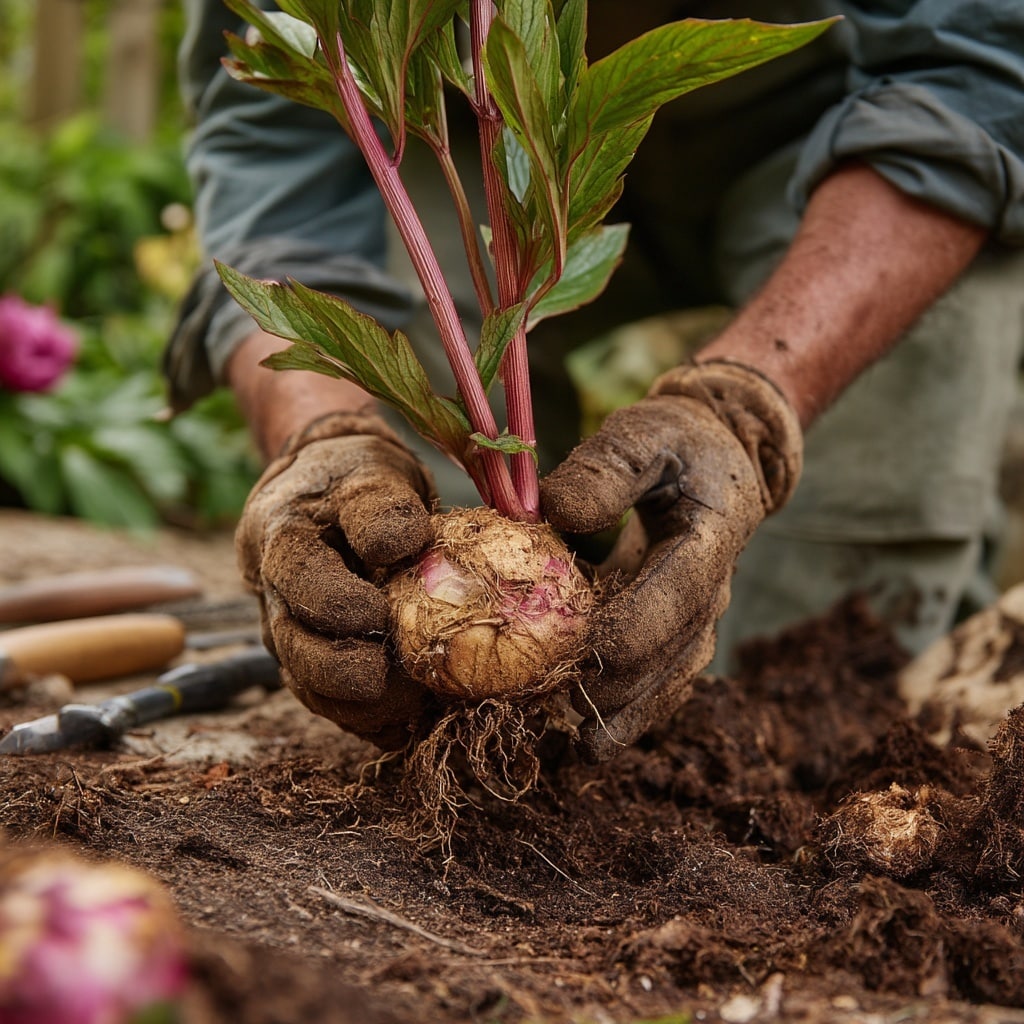
Although peonies don’t need frequent division, there are times when splitting a plant makes sense—such as when it becomes overcrowded, produces fewer blooms, or you simply want to share it with another gardener.
When to Divide:
- The best time to divide peonies is in fall, once the plant has gone dormant and after the foliage has been cut back.
- Avoid dividing in spring, as this can disrupt bud development.
How to Divide Peonies:
- Cut the foliage down to just above soil level.
- Use a garden fork or spade to gently dig around the root ball, taking care not to damage the thick tuberous roots.
- Wash or shake off excess soil to expose the “eyes” (the small pink or white growth buds).
- Use a clean, sharp knife to divide the root clump. Each division should have at least 3 to 5 eyes and strong roots.
- Replant divisions 1 to 2 inches below the soil surface, water well, and mulch lightly for the first winter.
With proper timing and technique, divided peonies will bloom again within a couple of years.
Types of Peonies (and Popular Varieties)

With thousands of cultivars available, peonies offer a wide range of flower forms, colors, and fragrances. Most fall into three main categories: herbaceous peonies, tree peonies, and Itoh (intersectional) peonies, each with unique characteristics and bloom times.
Main Peony Flower Types:
- Single – One row of petals with a visible center (e.g., ‘Sparkling Star’)
- Japanese – Decorative centers with upright petals (e.g., ‘Carrara’)
- Anemone – Soft, multi-layered centers, often lemon-colored (e.g., ‘Laura Dessert’)
- Semidouble – Several petal rows and a partially visible center (e.g., ‘Pink Hawaiian Coral’)
- Double – Full, ruffled blooms; classic “cabbage rose” look (e.g., ‘Candy Stripe’)
- Bomb – Large, puffed center atop flatter outer petals (e.g., ‘Angel Cheeks’)
Special Mention: Itoh Peonies
A hybrid between herbaceous and tree peonies, Itoh peonies offer large, long-lasting blooms on compact plants with sturdy stems. They bloom later than traditional varieties and require less support.
By combining types and bloom periods, you can extend your peonies’ display for several weeks each season.
Harvesting and Keeping Peonies in a Vase
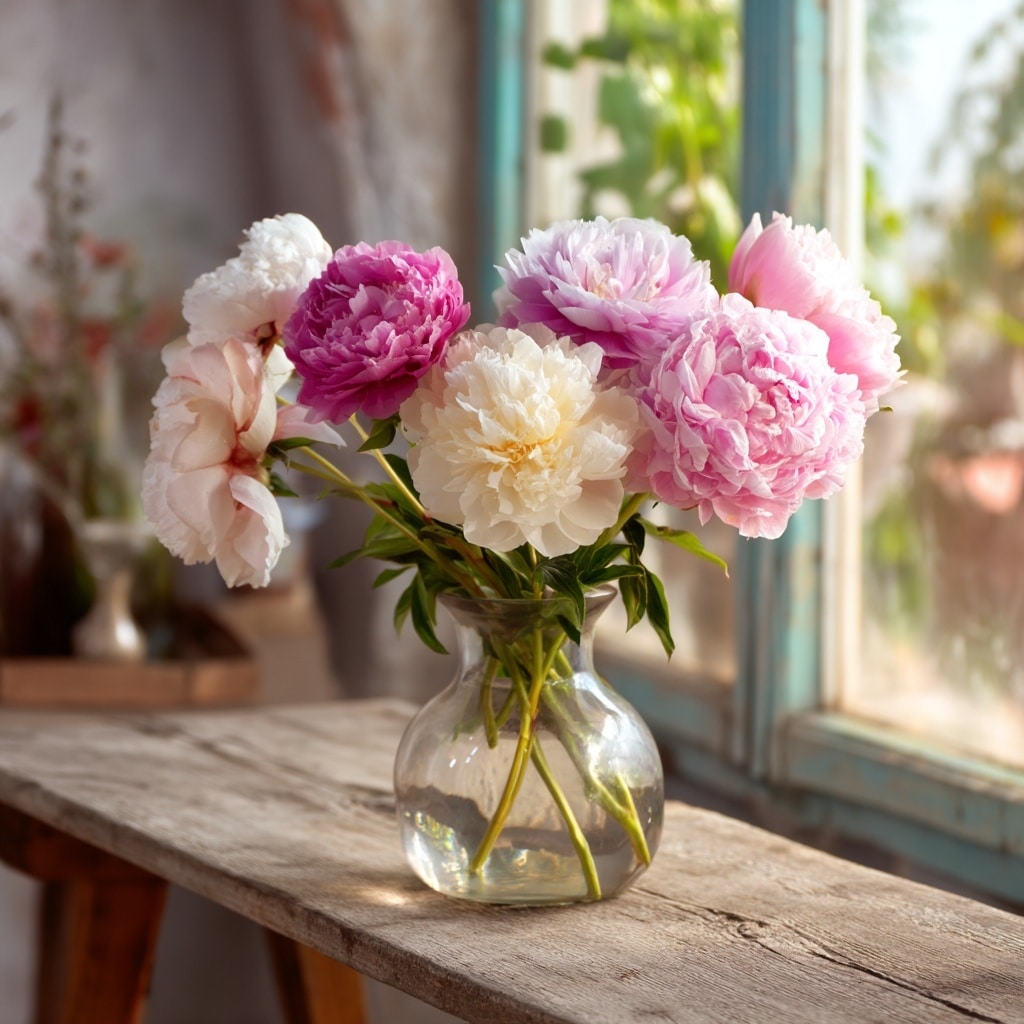
Fresh-cut peonies are a favorite for floral arrangements thanks to their lush, romantic blooms and long vase life. With the right timing and care, cut peonies can stay beautiful for up to a week—or even longer with proper storage.
When to Harvest:
- Cut blooms in the morning, when temperatures are cool and buds are still in the “marshmallow” stage—soft but not fully open.
- Use sharp, clean pruners and cut just above a healthy leaf set to encourage continued growth.
Tips for Vase Longevity:
- Immediately place stems in lukewarm water.
- Trim stem ends at an angle under running water to prevent air bubbles from blocking water flow.
- Keep arrangements out of direct sunlight and heat.
- Change the water every 2 to 3 days to prevent bacteria.
For later use, you can store harvested peonies in the fridge: wrap the stems in damp paper towels, place in a plastic bag, and chill for up to a week or more before use.
Common Pests and Peony Problems
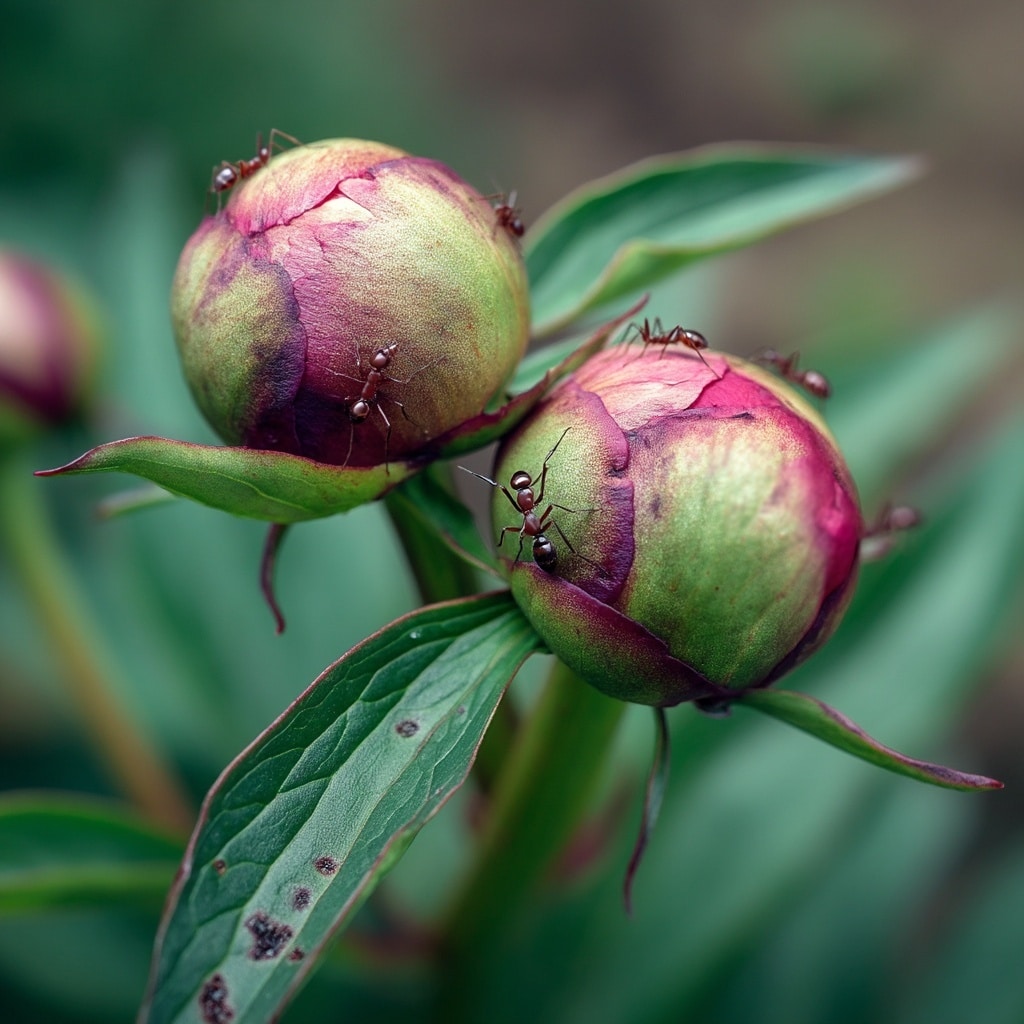
While peonies are generally hardy and resistant to most pests, they can still encounter a few issues—especially in damp or crowded conditions. The good news? Most problems are preventable with proper planting and care.
Common Diseases:
- Botrytis blight – Gray mold that causes stems to rot; often due to poor air circulation or wet conditions. Cut back and dispose of affected parts, and avoid overhead watering.
- Leaf blotch – Brown or purple spotting on leaves. Remove infected foliage and ensure good spacing between plants.
- Stem rot and tip blight – More common in heavy soils. Improve drainage and avoid planting too deep.
Pests to Watch For:
- Japanese beetles – Feed on flowers and leaves. Handpick or use traps.
- Aphids and nematodes – Can cause curling or stunted growth. Blast off with water or use insecticidal soap.
What About Ants?
Don’t worry if you see ants on your peonies—they’re simply attracted to the sweet nectar on buds and don’t harm the plant. In fact, they may help deter more harmful insects.
Keeping your peonies clean, dry, and well-spaced is the best defense against most problems.
FAQs About Peonies
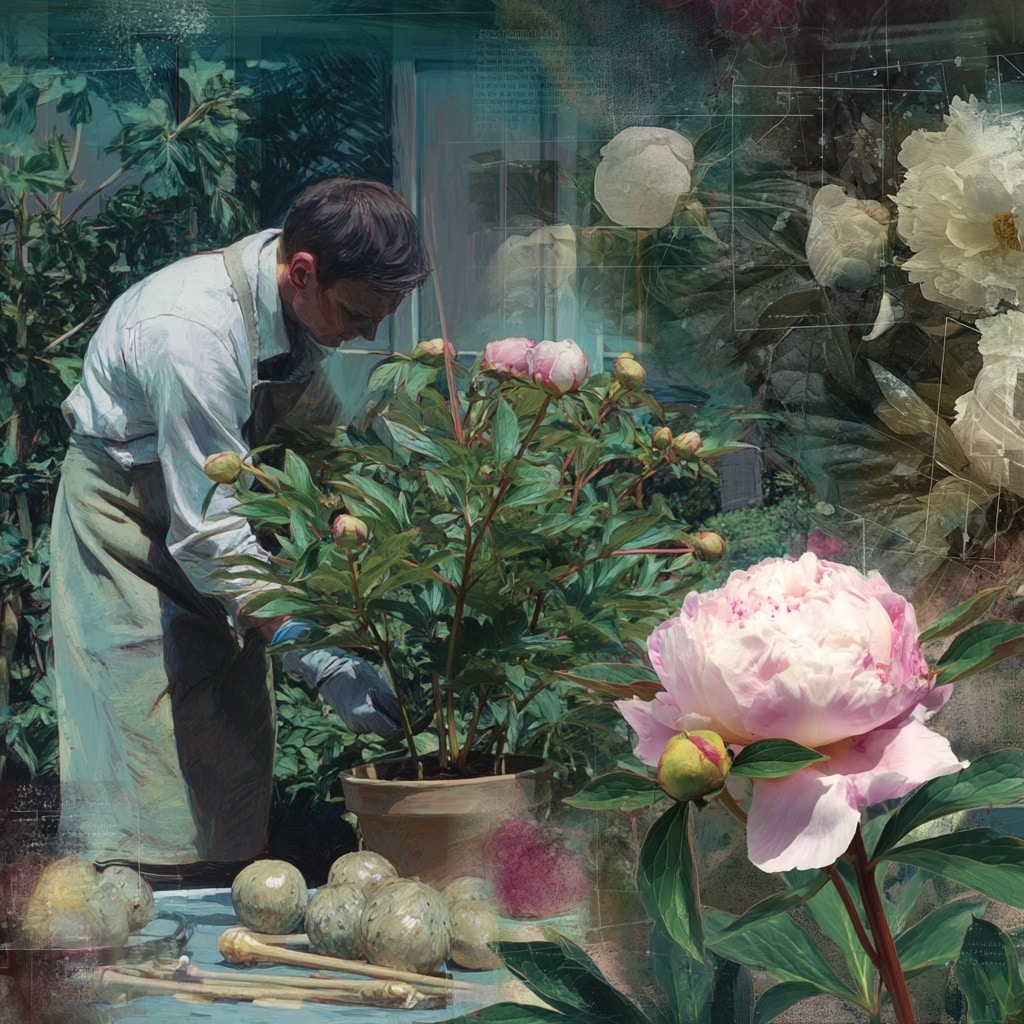
Why are there ants on my peonies?
Ants are attracted to the nectar on peony buds, especially as they begin to swell and prepare to open. This is completely normal—and harmless. Ants don’t damage the plant or affect bloom quality, so there’s no need to remove them. In fact, they may help fend off more harmful pests.
Why aren’t my peonies blooming?
Several issues can cause peonies to stop blooming:
- Planted too deep — Eyes should be no more than 2 inches below the soil.
- Too much nitrogen — This encourages foliage but not flowers.
- Too little sunlight — Peonies need at least 6 hours of direct sun daily.
- Lack of winter chill — Peonies need cold exposure to form buds.
- Foliage removed too early — Let the leaves die back naturally in fall.
Can I grow peonies from seed?
Yes, but patience is required. Peony seeds can take 2 to 3 years (or more) to mature into blooming plants. They need a warm/cold cycle to germinate properly, mimicking natural seasonal changes. Plant them about ½ inch deep and mulch lightly.
Can I grow peonies indoors?
It’s possible, but challenging. Peonies need chilling periods of 3–6 weeks at temperatures below 40°F to bloom. Indoor growers may need to simulate this using a cool garage, shed, or even the fridge. A large container, strong light, and well-draining soil are essential.
Conclusion
Growing peonies is one of the most rewarding joys in gardening. With their fragrant, oversized blooms, lush foliage, and long life span, peonies bring timeless beauty and elegance to any outdoor space. Once planted in the right location with good sunlight and well-drained soil, these perennials require very little attention to thrive year after year.
From proper planting depth to seasonal care and dividing old clumps, each step contributes to a healthier plant and better blooms. Whether you love peonies for their cut flowers, bold garden presence, or symbolic charm, they’re a classic worth investing in.

